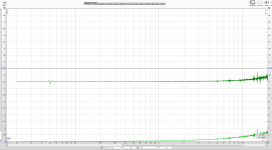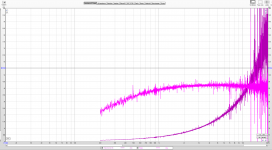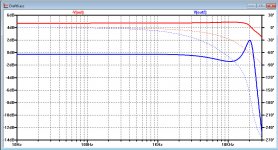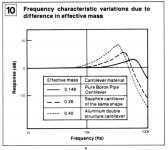G1042
47k sense
2M sweep
8 sweeps
impedance scaled x 1/10
-80dBU
47k sense
2M sweep
8 sweeps
impedance scaled x 1/10
-80dBU
Attachments
Last edited:
I have a problem with the interpretation of the different measured results.
Jack showed Cartridge dynamic behaviour that inductance dropped below a certain level, however David could not find such level dependency in Cartridge dynamic behaviour.
How come ?
I this apples to apples or are we looking at two different issues.
Hans
Jack showed Cartridge dynamic behaviour that inductance dropped below a certain level, however David could not find such level dependency in Cartridge dynamic behaviour.
How come ?
I this apples to apples or are we looking at two different issues.
Hans
I am inclined to agree now that this must be a mechanical resonance.
It would be an interesting experiment to play a test record noise track and measure the acoustic spectrum with an electret microphone nearby
IIRC Martin Colloms used ultra miniature accelerometers and measured tone arm resonances well down into the audio range. I have a Kistler miniature one, never tried it because I thought its presence would disturb things enough that it would only be a curiosity.
I this apples to apples or are we looking at two different issues.
I thought a good story for the rapid drop off of that magnitude didn't exist.
Thank you David,G1042
47k sense
2M sweep
8 sweeps
impedance scaled x 1/10
-80dBU
You mention -80dBu for this recording with 47K, meaning that you have now 14.9uV on the Cart.
And although the image is still noisy, it looks already better in the upper freq region than your previous recording with 5k1.
But to make the 47K and the 5k1 recordings 1:1 comparable, you should now apply -67dBu instead of -80dBu.
Hans
So it was just a measuring artefact of the HP3577 ?I thought a good story for the rapid drop off of that magnitude didn't exist.
Hans
The mechanical resonance that Bill mentioned in Cartridge dynamic behaviour, seems to possibly explain the dip in the FR at ca 10kHz and the peak at 20kHz (van Maanen & van Raalte).IIRC Martin Colloms used ultra miniature accelerometers and measured tone arm resonances well down into the audio range. I have a Kistler miniature one, never tried it because I thought its presence would disturb things enough that it would only be a curiosity.
But because of the large lift of over 10dB to compensate for the mechanical resonance with an inverse resonance filter (for this specific Stanton Cart), this option was rejected.
Why is that, what's wrong with this approach, to be used in combination with using a lower value for the termination resistor at 75usec or even lower like a virtual gnd Aurak sort of input ?
Or is it simply too complex, what I can very well understand.
In the image below, I have simulated a cart with mechanical resonance in blue, terminated with 47K//200pF and the version terminated with virtual gnd and anti resonance filter in red.
Notice apart from the flattened FR, also the much better phase response.
Hans
Attachments
Hans, this gets us back to the beginning. the van Maanen and van Raalte analysis on resonance has so far failed to materialise. I still hope to find it as it does match what is seen in some cases (but not in others). If it were real Aurak would not give a flat response.
Attached is a graph from either Denon or panasonic (can't recall) where they suggest resonant peak from a standard al tube and average stylus to be well above 20kHz (hard to tell without putting a log graph scale over the top).
Scott Jelco SA-950DB Measurements shows what you can do these days. I would love to get this setup.
Attached is a graph from either Denon or panasonic (can't recall) where they suggest resonant peak from a standard al tube and average stylus to be well above 20kHz (hard to tell without putting a log graph scale over the top).
Scott Jelco SA-950DB Measurements shows what you can do these days. I would love to get this setup.
Attachments
Scott Jelco SA-950DB Measurements shows what you can do these days. I would love to get this setup.
That's the arm my kids destroyed (along with the $300 cart). The full kit on that Endevco part is out of the hobby budget. The Kistler I have has the impedance converter built in and is not much bigger, I should weigh it.
BTW - I like this guys stuff (the crosstalk method of azimuth alignment is wrong, interesting).
Last edited:
The nature of the mech resonance matters. If it's spring mass it's a classic 2nd order system with a single resonant f. If it's beam bending then there's a series of impedance peaks and troughs. The mid f dip happens to be where the first trough lands roughly.The mechanical resonance that Bill mentioned in Cartridge dynamic behaviour, seems to possibly explain the dip in the FR at ca 10kHz and the peak at 20kHz (van Maanen & van Raalte).
But because of the large lift of over 10dB to compensate for the mechanical resonance with an inverse resonance filter (for this specific Stanton Cart), this option was rejected.
Why is that, what's wrong with this approach, to be used in combination with using a lower value for the termination resistor at 75usec or even lower like a virtual gnd Aurak sort of input ?
Or is it simply too complex, what I can very well understand.
In the image below, I have simulated a cart with mechanical resonance in blue, terminated with 47K//200pF and the version terminated with virtual gnd and anti resonance filter in red.
Notice apart from the flattened FR, also the much better phase response.
Hans
LD
Bill, the flat response was from a real Aurak, fed with a signal including mech. resonance and followed by a anti resonance filter.Hans, If it were real Aurak would not give a flat response.
Hans
LD, In what direction is your feeling sending you ?The nature of the mech resonance matters. If it's spring mass it's a classic 2nd order system with a single resonant f. If it's beam bending then there's a series of impedance peaks and troughs. The mid f dip happens to be where the first trough lands roughly.
LD
I tend towards a second order system where the cantilever is the spring, the magnet the mass and the suspension providing for the damping.
But would it make a difference when looking at it from a compensation point of view where eventual supersonic harmonics will be strongly attenuated ?
On the other hand, Bill gave us a link recently from a Philips guy, who showed that on an LP a similar proces takes place of two opposing forces together creating a through and a peak in the FR.
On one hand the higher the modulation, the more the needle wants to take a shortcut leading to a lower output, but on the other hand there is a resonance thing between needle tip (mass) and vinyl(spring) having a Fres extending the FR.
Just like the LCR and Resonance from the Cart are used to extend the FR.
In how far could this also be part of the equation ?
With all this its like magic that an LP produces any music at all. 😀
Hans
-80dBuV means 70 uVrms at the sense resistor, so varying voltage across the cartridge with frequency, just 1uV at low frequencies, rising to almost 70uV at 20 kHzYou mention -80dBu for this recording with 47K, meaning that you have now 14.9uV on the Cart.
And although the image is still noisy, it looks already better in the upper freq region than your previous recording with 5k1.
But to make the 47K and the 5k1 recordings 1:1 comparable, you should now apply -67dBu instead of -80dBu.
I have just upgraded to REW 5.20 beta6 and now using the 64 bit version with external 64 bit JRE. This allows more memory, so I was able to go for slower sweeps and average 8 sweeps to improve SNR.
I really need shielding and a quieter soundcard.
The opamp is noisy too, TLV2372 is a poor 39 nV/√Hz
I like reading his posts. He is trying to measure things that not many are, but does sometimes seem to come to the wrong conclusions.BTW - I like this guys stuff (the crosstalk method of azimuth alignment is wrong, interesting).
If that is true (beam bending) then its a universal thing, not just MMs which would make me far more comfortable.The nature of the mech resonance matters. If it's spring mass it's a classic 2nd order system with a single resonant f. If it's beam bending then there's a series of impedance peaks and troughs. The mid f dip happens to be where the first trough lands roughly.
LD
The graph I posted of LDs OM measurements (normal not super) is with no mech resonance correction. There is a slight HF rise consistent with an ultrasonic cantilever resonance but its small in the audioband. Looking at that, is there much to correct?Bill, the flat response was from a real Aurak, fed with a signal including mech. resonance and followed by a anti resonance filter.
Hans
Bill,The graph I posted of LDs OM measurements (normal not super) is with no mech resonance correction. There is a slight HF rise consistent with an ultrasonic cantilever resonance but its small in the audioband. Looking at that, is there much to correct?
could you give me a link to where to find these OM measurements.
Are the inductance and series resistance known for this cart and were these measurements done with an Aurak or with 47K//200pF ?
I'll try to replicate the curve in LTspice with the above information included and come back to you how much correction would eventually be needed to flatten the curve.
In fact what would be needed to put this correction into practice additionally to Riaa is an anti resonance filter with variable Fres and Q, enabling an optimal correction for every Cart.
The most ideal would be to do this in the digital domain giving all the flexibility you need, just like the Riaa correction that you also have planned to perform digitally.
Hans
Post 493 Cartridge dynamic behaviour
This was with LDs own Aurak as per his published circuit. There are some 'corrections' in that, but never simulated that.
Edit mechanical resonance in MMs I believe this is the version that was used for the measurement in #493
This was with LDs own Aurak as per his published circuit. There are some 'corrections' in that, but never simulated that.
Edit mechanical resonance in MMs I believe this is the version that was used for the measurement in #493
Last edited:
I was referring to 3Khz, the selected frequency for doing the measurements.-80dBuV means 70 uVrms at the sense resistor, so varying voltage across the cartridge with frequency, just 1uV at low frequencies, rising to almost 70uV at 20 kHz
I have just upgraded to REW 5.20 beta6 and now using the 64 bit version with external 64 bit JRE. This allows more memory, so I was able to go for slower sweeps and average 8 sweeps to improve SNR.
I really need shielding and a quieter soundcard.
The opamp is noisy too, TLV2372 is a poor 39 nV/√Hz
Here you settled a new low record with only 15uV on the cart instead of the previous 66uV, a difference of 13dB and because of that noise-wise incomparable
A slight addition, 0dBu is the voltage to produce 1mW into 600 Ohm, representing a voltage of sqrt(0.6)=0.775 Volt.
In case you have the TLV2372 in a SOT23 package, you could replace it with a SM72501, also RRIO Cmos, with only 10nV/rthz.
Succes with upgrading your gear,
Hans
Thank you, that's all the info I need.Post 493 Cartridge dynamic behaviour
This was with LDs own Aurak as per his published circuit. There are some 'corrections' in that, but never simulated that.
Edit mechanical resonance in MMs I believe this is the version that was used for the measurement in #493
Hans
If that is true (beam bending) then its a universal thing, not just MMs which would make me far more comfortable.
I just remembered that the STR-112 had a complete suite of sweeps L/R/lateral/vertical at three diameters of the disk. Looking up the original data there is significant difference (mid droop) between channels and at the inner diameter, I don't know what to make of this except that there is more than one thing going on.
After observing how much time and energy (and money) Kevin has spent on LP, I simply don't have the energy to start over on it.
- Status
- Not open for further replies.
- Home
- Source & Line
- Analogue Source
- Cartridge dynamic behaviour



